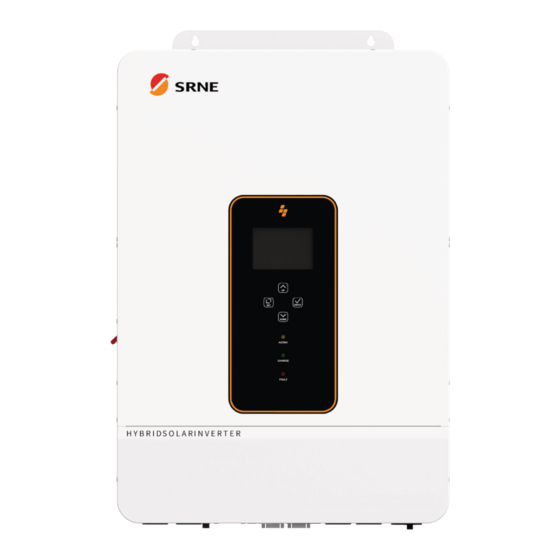
Table of Contents
Advertisement
Quick Links
Advertisement
Table of Contents

Summarization of Contents
Safety
How to use this manual
Provides essential information, guidelines, operation, and maintenance details for the ASF series inverters.
Symbols in this manual
Explains the meaning of danger, warning, caution, and notice symbols used throughout the manual.
Safety instructions
Details critical safety precautions for installation, operation, and maintenance to prevent injury and damage.
Production Instructions
Instructions
Introduces the ASF series as a new type of solar energy storage inverter with advanced control.
Features
Lists key features like battery support, output modes, MPPT, charging modes, and protections.
System connection diagram
Illustrates the system components and their connections for the solar charge inverter.
Production Overview
Provides a detailed diagram of the inverter's physical layout and component identification.
Installation
Select the mount location
Guides on choosing a suitable indoor location, considering wall type, height, heat dissipation, and ambient temperature.
Mount the inverter
Details the process of drilling mounting holes and fixing the inverter using screws and expansion bolts.
Remove the terminal cover
Explains how to remove the terminal protection cover using a screwdriver for access to connections.
Connection
Connection Overview
Explains split-phase and single-phase connection modes, including diagrams and voltage ranges.
Cable & circuit breaker requirement
Specifies required cable diameters and circuit breaker ratings for PV input, AC input, and battery connections.
AC input & output connection
Details how to connect live, neutral, and ground wires for AC input and output terminals.
Battery Connection
Guides on connecting the positive and negative cables of the battery to the inverter terminals.
PV connection
Instructs on connecting the positive and negative wires for the two PV strings, with voltage warnings.
Dry contact connection
Describes connecting communication cables to the dry junction port for specific functions.
Grounding connection
Emphasizes connecting the grounding terminal to the grounding bar for safety.
Final assembly
Instructs to install the terminal protection cover after ensuring wiring is correct and reliable.
Start up the inverter
Provides a step-by-step guide for safely powering on the inverter and connected loads.
Operation
Operation and display panel
Details the components of the control panel: LCD screen, indicators, and touchable keys.
Setting
Explains how to navigate the setup menu to configure various parameters like output priority and frequency.
AC output mode
Describes different AC output modes (Utility, Solar, Hybrid, Inverter priority) based on parameter settings.
Battery charging mode
Explains various battery charging modes (Hybrid, Utility, Solar Priority, Only Solar) and their priorities.
Time-slot charging/discharging function
Details the function for setting custom charging/discharging times based on tariffs to optimize costs.
Battery parameter
Lists and explains battery parameters for different battery types (Sealed, Gel, Flooded, Li-ion, User-defined).
Communication
Overview
Provides an overview of the communication ports available on the inverter, including USB, RS485, CAN, and Dry Contact.
USB-B port
Explains the use of the USB-B port for reading and modifying device parameters using host software.
RS485–1 port
Details the RS485-1 port connection for Wi-Fi/GPRS data acquisition modules for mobile APP monitoring.
CAN/RS485-2 port
Describes the CAN/RS485-2 port used for connecting to the BMS of Li-ion batteries.
Dry contact
Explains the four functions of the dry contact port: remote switch, signal output, temperature sampling, and generator control.
Fault and Remedy
Fault code
Lists fault codes, their meanings, impact on outputs, and instructions for resolution.
Troubleshooting
Provides a guide to diagnose and resolve common issues such as no display or battery connection problems.
Protection and Maintenance
Protection features
Details various protection mechanisms implemented in the inverter to ensure safe and reliable operation.
Maintenance
Recommends regular checks and maintenance tasks to ensure optimal and long-lasting performance of the inverter.














Need help?
Do you have a question about the ASF48100U200-H and is the answer not in the manual?
Questions and answers